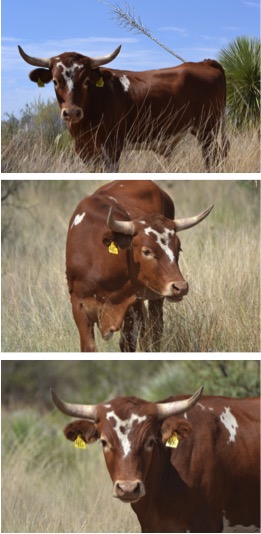|
At the Jornada Experimental Range in Las Cruces, New Mexico, a unique breed type of cattle is thriving in the arid lands of the Desert Southwest. These gentle animals with their multi-colored coats and upsweeping horns are Criollo cattle with a set of genes that sets them apart from other cattle. These unique genetics are a result of their long 500-year history in the Americas, and scientists at the Jornada are uncovering how these genes allow them to survive in harsh lands with minimal or no supplements provided by ranchers. The Criollo at the Jornada are from Copper Canyon in Northern Mexico, where they were kept by the Tarahumara people for hundreds of years. Unlike many breeds whose genetic traits were selected by people, the Criollo cattle in Mexico are the result of 100-200 generations of natural selection. The result of this unmanaged breeding is that these cattle are extremely well adapted to the varied climates of Copper Canyon. Those living at lower elevations do well in the heat; those from higher elevations do well in their cooler environments. The Jornada obtained 30 cows and 3 bulls from that area in 2001. The breed type is the Raramuri Criollo, meaning “light-footed ones” as named by the Tarahumara people in their language. The Jornada now has ~300 Raramuri Criollo which they are utilizing in their research program. While the work is still ongoing, preliminary results show many advantages that allow them to thrive. Criollo appear to graze a great variety of vegetation including grasses, shrubs and forbs. This trait makes Criollo suitable for large pastures and extensive management since their diverse diet allows them to utilize more of the land.
|
The learned adaptations of the Raramuri Criollo allow them to walk much further than other breed types. Preliminary observations show they will use 60% more of the land, distributing themselves across it better, and thus reducing the chance of over-grazing. They also appear to go longer without drinking water, which may be a contributing factor in their ability to walk such distances. Criollo are much smaller than typical beef cows, (800 lbs. vs. over 1000 lbs. or more for the large beef breeds). They are also slower growing, taking 30 months to finish growth, compared to 18 months for beef breeds. Although this is often viewed as a negative, it can be an advantage in some cases because their impact on grazing land and their need for supplemental feed is minimal. Ranchers in semi-arid lands have found great success with traditional European breed. There are many ways in which a ranching enterprise can be successful and profitable. Alfredo Gonzalez, Animal Scientist at the Jornada Experimental Range, believes that the smaller Criollo provide another option that ranchers can adopt if it suits them. “The big difference is Criollo are better utilizers of the land. We can see that with heavier breeds, like (classic) beef breeds, there (can be) over-utilization of the land. This causes it to change from grassland to shrubs. Over-grazing isn’t the only factor, but we see that change happening. So cattle producers must think of this (option).” Criollo are also good for a ranch’s bottom line. Based on a preliminary economic study, and including a few assumptions based on the Jornada’s experience, “Criollo can use 60% more of the land than beef breeds. It takes 30 months, but we still make 19% more profit per year with Criollo than with beef breeds. We are able to use more land, use it less intensively, and we are making more of a profit. It’s a win-win situation!” Many ranchers throughout the Southwest are indeed bringing Criollo onto their ranches, including Dennis Moroney of 47 Ranch in Arizona, for whom Raramuri Criollo has completely changed how he ranches, and whose customers love the taste of his Criollo beef. |





